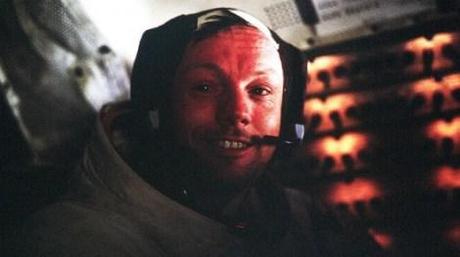
Neil Armstrong, the test pilot, aerospace engineer, university professor, United States Naval Aviator and American astronaut, has died at the age of 82 in Cincinnati, Ohio. His death was due to complications resulting from recent cardiovascular procedures carried out to relieve blocked arteries. He will forever be remembered by the history books as the first man to step foot on the Moon, the defining moment for a generation and inspiration to the generations that followed.
Early taste for flying
Born on August 5, 1930, in Wapakoneta, Ohio, he acquired a love for flying early with his father taking him to the Cleveland Air Races when he was just two. He had his first airplane flight when he was six in a Ford Trimotor and, after his family moved to Wapakoneta in 1944, he began taking flying lessons at the county airport. He earned his flight certificate when he was 15, before he even had a driver’s license.
Although he was accepted to MIT, he began attending Purdue University in 1947 where he studied aerospace engineering with his college tuition paid under the Holloway Plan. This required him to commit to two years of study, followed by three years of service in the U.S. Navy, before finishing the degree with another two years of study.
In January 1949, Armstrong received a call-up from the Navy to report to Naval Air Station Pensacola for flight training. After almost 18 months, he qualified for carrier landing and in August, 1950, he received notification that he was a fully qualified Naval Aviator.
After being assigned to Fleet Aircraft Service Squadron 7 at NAS San Diego and then the all-jet Fighter Squadron 51, he made his first jet flight in an F9F-2B Panther in January, 1951. This was followed by his first jet carrier landing in June. That month he was also promoted from Midshipman to Ensign and was bound for Korea.
Armstrong flew 78 missions over Korea, racking up a total of 121 flight hours with the majority of missions flying armed reconnaissance over the primary transportation and storage facilities south of the village of Majon-ni. He received the Air Medal for 20 combat missions, a Gold Star for the next 20, and the Korean Service Medal and Engagement Star, before leaving the Navy on August 23, 1952, and becoming a Lieutenant, Junior Grade in the U.S. Naval Reserve.
He the returned to Purdue, where he met Janet Elizabeth Shearon, who would become his first wife on January 28, 1956. He received his Bachelor of Science degree in aeronautical engineering from Purdue in 1955, before later gaining a Master of Science degree in aerospace engineering from the University of Southern California in 1970, along with honorary doctorates from numerous universities.
Testing times
After graduating from Purdue, Armstrong become an experimental research test pilot at the National Advisory Committee for Aeronautics High-Speed Flight Station at Edwards Air Force Base in July 1955, where he logged over 900 flights in more than 200 different aircraft, including the Bell X-1B, the North American X-15 and the Lockheed F-104 Starfighter. During this time, he was involved in a number of incidents and while many test pilots praised his engineering ability, others felt that pilot-engineers like Armstrong flew in a way that was more mechanical than those with natural flying ability.
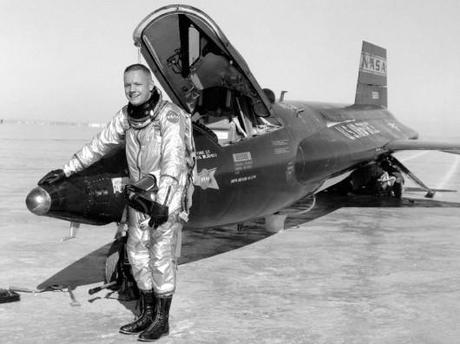
In 1958, he was selected for the U.S. Air Force’s Man in Space Soonest program, which was attempting to beat the Soviet Union in putting a man into outer space. The program was cancelled later that year and replaced with NASA’s Project Mercury in 1959. After his application to become part of the second group of NASA astronauts in June, 1962, he joined the NASA Astronaut Corps in September of that year as one of two civilian pilots selected for the group of nine.
On September 20, 1965, Armstrong was announced as Command Pilot for Gemini 8, which launched on March 16, 1966. This mission involved the first-ever docking between two spacecraft. Although the docking was successful, the docked spacecraft began to roll and the mission ultimately had to be cut short with most of the objectives – including a planned EVA by the pilot David Scott – had to be cancelled.
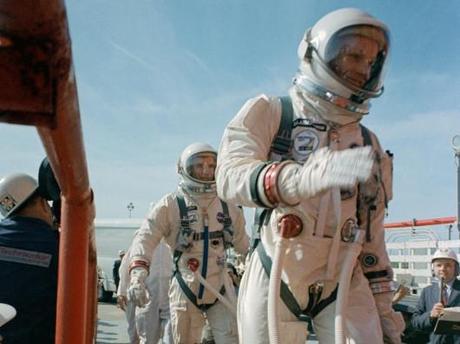
Armstrong then served as CAPCOM on Gemini 11, which launched on September 12, 1966, before serving as backup commander for Apollo 8. As Apollo 8 orbited the Moon on December 23, 1968, Armstrong was offered the post of commander of Apollo 11. A March 1969 meeting between NASA management gave Armstrong the thumbs up to be the first man on the Moon. This was supposedly at least partly because he was seen as a person without a big ego, although the design of the Lunar Module (LM) cabin was given as the official reason.
That giant leap

At 20:17:39 UTC on July 20, 1969, the LM touched down on the surface of the Moon. A few hours later, at 2:56 UTC on July 21, 1969, Armstrong descended the ladder from the LM and set his left foot down on the lunar surface to say, “That’s one small step for [a] man, one giant leap for mankind.”
Although Armstrong claimed that the “a” was obscured by static in the broadcast, he eventually conceded he may have dropped it. He is quoted later in Guidebook for the scientific traveler: visiting astronomy and space, that he “would hope that history would grant me leeway for dropping the syllable and understand that it was certainly intended, even if it was not said – although it might actually have been.” However, more recent analysis is said to confirm Armstrong did indeed say “a man,” although this has not been absolutely confirmed.
Whether he did or he didn’t, from that moment on Neil Armstrong became one of the most recognizable names in human history. Out of an estimated world population of 3.6 billion, it is estimated that around 600 million people watched the grainy TV images. He was joined some 20 minutes later by Buzz Aldrin and the two planted the flag of the United States, which – as Aldrin said – appears to have toppled over when the LM’s Ascent stage lifted off.
A household name
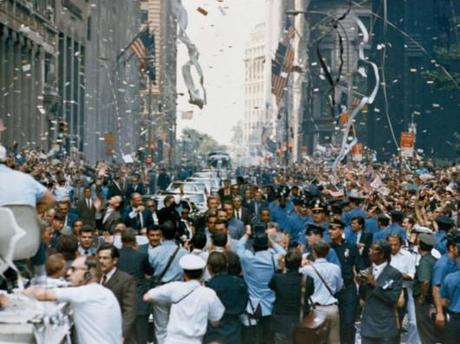
After returning to Earth, Armstrong and his crew-mates took part in a 45-day “Giant Leap” tour across the U.S. and around the world and he also took part in Bob Hope’s 1969 USO show. However, he largely shunned the spotlight and announced his intention not to fly in space again shortly after Apollo 11.
He then became Deputy Associate Administrator for aeronautics for the Office of Advanced Research and Technology, Advanced Research Projects Agency (ARPA), but served in this position for only a year before resigning from it and NASA as a whole in 1971.
He then went into teaching, taking a position in the Department of Aerospace Engineering at the University of Cincinnati. Despite having offers from bigger and better known schools, he made this decision as he was concerned that faculty members at other schools might have been annoyed that he came straight into a professorship with only the USC master’s degree. After eight years teaching, he resigned in 1979 with no explanation as to why.
During his years teaching, he was approached by numerous businesses wishing to employ him as a spokesman but he turned down all offers. This was until 1979, when he began appearing in advertisements for Chrysler, as he believed it had a strong engineering division and were also in financial difficulty. He also acted as a spokesman for General Time Corporation and the Banker’s Association of America. He also served on the board of directors of several companies and served on the Rogers Commission that investigated the Space Shuttle Challenger disaster.
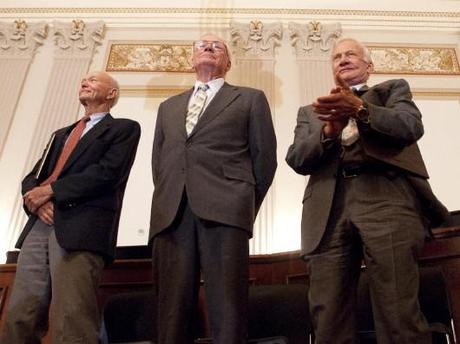
In February, 1991, Armstrong suffered a mild heart attack while skiing at Aspen, Colorado. Following complications resulting from surgery on August 7, 2012, to relieve blocked coronary arteries, Armstrong passed away on August 25, in Cincinnati, Ohio, prompting accolades from friends, family and world leaders.
Tributes
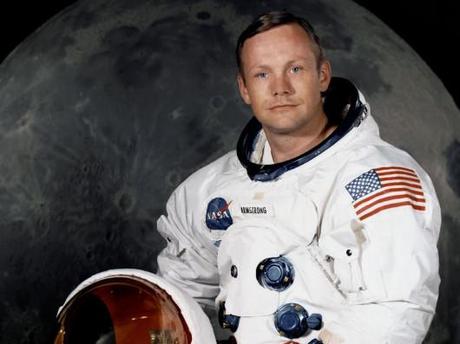
Armstrong’s family released a statement saying, “Neil Armstrong was also a reluctant American hero who always believed he was just doing his job. He served his Nation proudly, as a navy fighter pilot, test pilot, and astronaut. He also found success back home in his native Ohio in business and academia, and became a community leader in Cincinnati.
While we mourn the loss of a very good man, we also celebrate his remarkable life and hope that it serves as an example to young people around the world to work hard to make their dreams come true, to be willing to explore and push the limits, and to selflessly serve a cause greater than themselves.”
Apollo 11 crew-mate Buzz Aldrin said, “I am very saddened to learn of the passing of Neil Armstrong today. Neil and I trained together as technical partners but were also good friends who will always be connected through our participation in the Apollo 11 mission. Whenever I look at the moon it reminds me of the moment over four decades ago when I realized that even though we were farther away from earth than two humans had ever been, we were not alone.”
NASA Administrator Charles Bolden said, “as long as there are history books, Neil Armstrong will be included in them, remembered for taking humankind’s first small step on a world beyond our own,” adding, “besides being one of America’s greatest explorers, Neil carried himself with a grace and humility that was an example to us all.”
President Barack Obama said via Twitter, “Neil Armstrong was a hero not just of his time, but of all time. Thank you, Neil, for showing us the power of one small step.”
Source: NASA

